Elliptic Array Luminescent Solar Concentrators for Combined Power Generation and Microalgae Growth
Abstract
:1. Introduction
2. Background
3. Description of the Elliptic Array Solar Spectrum Splitter and Simulation Methods
4. Results
4.1. Surface Scattering Losses in the EASSS
4.2. Absorption Losses in the EASSS
4.3. Transmission Losses in the EASSS
4.4. Optical Receiver Design
4.4.1. Emission Losses as a Function of the Optical Receiver Design
4.4.2. Emission Losses as a Function of the Volume Occupied by the Luminescent Dye in the Vicinity of the EASSS Focal Line
4.5. Performance Comparison: EASSS vs. Conventional LSC Panels
4.6. Thermal Analysis
4.7. Tandem Elliptic Array LSC-PBR for Combined Power and Algae Production
5. Conclusions
Supplementary Materials
Author Contributions
Funding
Institutional Review Board Statement
Informed Consent Statement
Data Availability Statement
Conflicts of Interest
References
- International Space Exploration Coordination Group. The Global Exploration Roadmap; ISECG: Pasadena, CA, USA, 2018. [Google Scholar]
- NASA. NASA’s Journey to Mars: Pioneering Next Steps in Space Exploration; Government Printing Office: Washington, DC, USA, 2015. [Google Scholar]
- ESA. Exploring Together, ESA Space Exploration Strategy; ESA: Noordwijk, The Netherlands, 2015. [Google Scholar]
- Helisch, H.; Keppler, J.; Detrell, G.; Belz, S.; Ewald, R.; Fasoulas, S.; Heyer, A.G. High density long-term cultivation of chlorella vulgaris SAG 211-12 in a novel microgravity-capable membrane raceway photobioreactor for future bioregenerative life support in SPACE. Life Sci. Space Res. 2020, 24, 91–107. [Google Scholar] [CrossRef]
- Revellame, E.D.; Aguda, R.; Chistoserdov, A.; Fortela, D.L.; Hernandez, R.A.; Zappi, M.E. Microalgae cultivation for space exploration: Assessing the potential for a new generation of waste to human life-support system for long duration space travel and planetary human habitation. Algal Res. 2021, 55, 102258. [Google Scholar] [CrossRef]
- Hendrickx, L.; De Wever, H.; Hermans, V.; Mastroleo, F.; Morin, N.; Wilmotte, A.; Janssen, P.; Mergeay, M. Microbial ecology of the closed artificial ecosystem MELiSSA (Micro-Ecological Life Support System Alternative): Reinventing and compartmentizing the Earth’s food and oxygen regeneration system for long-haul space exploration missions. Res. Microbil. 2006, 157, 77–86. [Google Scholar] [CrossRef]
- Helisch, H.; Belz, S.; Keppler, J.; Detrell, G.; Henn, N.; Fasoulas, S.; Ewald, R.; Angerer, O. Non-axenic microalgae cultivation in space—Challenges for the membrane μgPBR of the ISS experiment PBR@LSR. In Proceedings of the 48th International Conference on Environmental Systems, Alburquerque, NM, USA, 8–12 July 2018. [Google Scholar]
- Sanders, M.H.; Sedwick, R.J. Thermal design and performance of a LSC for space power generation. J. Spacecr. Rocket. 2019, 56, 1831–1837. [Google Scholar] [CrossRef]
- Needell, D.R.; Bauser, H.; Phelan, M.; Bukowsky, C.R.; Ilic, O.; Kelzenberg, M.D.; Atwater, H.A. Ultralight Luminescent Solar Concentrators for Space Solar Power Systems. In Proceedings of the 2019 IEEE 46th Photovoltaic Specialists Conference (PVSC), Chicago, IL, USA, 16–21 June 2019; pp. 2798–2801. [Google Scholar]
- Mohsenpour, S.F.; Richards, B.S.; Willoughby, N. Spectral conversion of light for enhanced microalgae growth rates and photosynthetic pigment production. Bioresour. Technol. 2012, 125, 75–81. [Google Scholar] [CrossRef]
- Detweiler, A.M.; Mioni, C.E.; Hellier, K.L.; Allen, J.J.; Carter, S.A.; Bebout, B.M.; Fleming, E.E.; Corrado, C.; Prufert-Bebout, L.E. Evaluation of wavelength selective photovoltaic panels on microalgae growth and photosynthetic efficiency. Algal Res. 2015, 9, 170–177. [Google Scholar] [CrossRef]
- Lamnatou, C.; Chemisana, D. Solar radiation manipulations and their role in greenhouse claddings: Fluorescent solar concentrators, photoselective and other materials. Renew. Sustain. Energy Rev. 2013, 27, 175–190. [Google Scholar] [CrossRef]
- Corrado, C.; Leow, S.W.; Osborn, M.; Chan, E.; Balaban, B.; Carter, S.A. Optimization of gain and energy conversion efficiency using front-facing photovoltaic cell luminescent solar concentrator design. Sol. Energy Mater. Sol. Cells 2013, 111, 74–81. [Google Scholar] [CrossRef]
- Wondraczek, L.; Batentschuk, M.; Schmidt, M.A.; Borchardt, R.; Scheiner, S.; Seemann, B.; Schweizer, P.; Brabec, C.J. Solar spectral conversion for improving the photosynthetic activity in algae reactors. Nat. Commun. 2013, 4, 2047. [Google Scholar] [CrossRef]
- Ooms, M.D.; Dinh, C.T.; Sargent, E.H.; Sinton, D. Photon management for augmented photosynthesis. Nat. Commun. 2016, 7, 12699. [Google Scholar] [CrossRef]
- Yahui, S.; Huang, Y.; Liao, Q.; Fu, Q.; Zhu, X. Enhancement of microalgae production by embedding hollow light guides to a flat-plate photobioreactor. Bioresour. Technol. 2016, 207, 31–38. [Google Scholar]
- Ooms, M.D.; Jeyaram, Y.; Sinton, D. Wavelength-selective plasmonics for enhanced cultivation of microalgae. Appl. Phys. Lett. 2015, 106, 063902. [Google Scholar] [CrossRef]
- Daigle, Q.; O’Brien, P.G. Heat generated using Luminescent Solar Concentrators for Building Energy Applications. Energies 2020, 13, 5574. [Google Scholar] [CrossRef]
- Papakonstantinou, I.; Portnoi, M.; Debije, M.G. The Hidden Potential of Luminescent Solar Concentrators. Adv. Energy Mater. 2020, 11, 2002883. [Google Scholar] [CrossRef]
- Arp, T.B.; Barlas, Y.; Aji, V.; Gabor, N.M. Natural Regulation of Energy Flow in a Green Quantum Photocell. Nano Lett. 2016, 16, 7461–7466. [Google Scholar] [CrossRef] [PubMed] [Green Version]
- Whitmarsh, J. The photosynthetic process. In Concepts in Photobiology: Photosynthesis and Photomorphogenesis; Singhal, G.S., Renger, G., Sopory, S.K., Irrgang, K.-D., Govindjee, Eds.; Narosa Publishers and Kluwer Academic: New Delhi, India, 1999; pp. 11–51. [Google Scholar]
- Wang, X.; Zhiming, M.W. (Eds.) High Efficiency Solar Cells: Physics, Materials, and Devices; Springer Series in Materials Science; Springer Science & Business Media: Berlin/Heidelberg, Germany, 2014. [Google Scholar]
- Debije, M.G.; Verbunt, P.P. Thirty years of luminescent solar concentrator research: Solar energy for the built environment. Adv. Energy Mater. 2021, 2, 12–35. [Google Scholar] [CrossRef]
- Correia, S.F.; de Zea Bermudez, V.; Ribeiro, S.J.L.; André, P.S.; Ferreira, R.A.S.; Carlos, L.D. Luminescent solar concentrators: Challenges for lanthanide-based organic–inorganic hybrid materials. J. Mater. Chem. A 2014, 2, 5580–5596. [Google Scholar] [CrossRef]
- Meinardi, F.; Colombo, A.; Velizhanin, K.A.; Simonutti, R.; Lorenzon, M.; Beverina, L.; Viswanatha, R.; Klimov, V.I.; Brovelli, S. Large-area luminescent solar concentrators based on ‘Stokes-shift-engineered’ nanocrystals in a mass-polymerized PMMA matrix. Nat. Photonics 2014, 8, 392–399. [Google Scholar] [CrossRef]
- Buffa, M.; Debije, M.G. Dye-doped polysiloxane rubbers for luminescent solar concentrator systems. In High-Efficiency Solar Cells; Springer: Cham, Switzerland, 2014; pp. 247–266. [Google Scholar]
- Zhao, Y.; Meek, G.A.; Levine, B.G.; Lunt, R.R. Near-Infrared Harvesting Transparent Luminescent Solar Concentrators. Adv. Opt. Mater. 2014, 2, 606–611. [Google Scholar] [CrossRef]
- Debije, M.G.; Teunissen, J.P.; Kastelijn, M.J.; Verbunt, P.P.C.; Bastiaansen, C.W.M. The effect of a scattering layer on the edge output of a luminescent solar concentrator. Sol. Energy Mater. Sol. Cells 2009, 93, 1345–1350. [Google Scholar] [CrossRef]
- Cambié, D.; Zhao, F.; Hessel, V.; Debije, M.G.; Noël, T. Every photon counts: Understanding and optimizing photon paths in luminescent solar concentrator-based photomicroreactors (LSC-PMs). React. Chem. Eng. 2017, 2, 561–566. [Google Scholar] [CrossRef] [Green Version]
- Chou, C.H.; Chuang, J.K.; Chen, F.C. High-performance flexible waveguiding photovoltaics. Sci. Rep. 2013, 3, 2244. [Google Scholar] [CrossRef] [PubMed]
- Toledo, C.; Scognamiglio, A. Agrivoltaic Systems Design and Assessment: A Critical Review, and a Descriptive Model towards a Sustainable Landscape Vision (Three-Dimensional Agrivoltaic Patterns). Sustainability 2021, 12, 6871. [Google Scholar] [CrossRef]
- Corrado, C.; Leow, S.W.; Osborn, M.; Carbone, I.; Hellier, K.; Short, M.; Alers, G.; Carter, S.A. Power generation study of luminescent solar concentrator greenhouse. J. Renew. Sustain. Energy 2016, 8, 043502. [Google Scholar] [CrossRef] [Green Version]
- Loik, M.E.; Carter, S.A.; Alers, G.; Wade, C.E.; Shugar, D.; Corrado, C.; Jokerst, D.; Kitayama, C. Wavelength-selective solar photovoltaic systems: Powering greenhouses for plant growth at the food-energy-water nexus. Earth’s Future 2017, 10, 1044–1053. [Google Scholar] [CrossRef]
- Bernardoni, P.; Vincenzi, D.; Mangherini, G.; Boschetti, M.; Andreoli, A.; Gjestila, M.; Samà, C.; Gila, L.; Palmery, S.; Tonezzer, M.; et al. Improved Healthy Growth of Basil Seedlings under LSC Filtered Illumination. In Proceedings of the 37th European Photovoltaic Solar Energy Conference and Exhibition, Munich, Germany, 7–11 September 2020; pp. 1767–1771. [Google Scholar]
- Talebzadeh, N.; O’Brien, P.G. Selective Solar Concentrators for Biofuel Production and Photovoltaic Applications. In Proceedings of the International Conference of Energy Harvesting, Storage, and Transfer (EHST’17), Toronto, ON, Canada, 21–23 August 2017. [Google Scholar]
- Daigle, Q.; Talebzadeh, N.; O’Brien, P.G.; Rauf, I.A. Spectral Splitting Luminescent Solar Concentrator Panels for Agrivoltaic Applications. In Proceedings of the 3rd International Conference of Energy Harvesting, Storage, and Transfer (EHST’19), Ottawa, ON, Canada, 18–19 June 2019; Volume 3, pp. 132–133. [Google Scholar]
- Debije, M.G.; Verbunt, P.P.C.; Rowan, B.C.; Richards, B.S.; Hoeks, T.L. Measured surface loss from luminescent solar concentrator waveguides. Appl. Opt. 2008, 47, 6763–6768. [Google Scholar] [CrossRef]
- Verbunt, P.P.C.; Tsoi, S.; Debije, M.G.; Boer, D.J.; Bastiaansen, C.W.M.; Lin, C.W.; de Boer, D.K.G. Increased efficiency of luminescent solar concentrators after application of organic wavelength selective mirrors. Opt. Express 2012, 20, A655–A668. [Google Scholar] [CrossRef] [PubMed] [Green Version]
- Mulder, C.L.; Reusswig, P.D.; Beyler, A.P.; Kim, H.; Rotschild, C.; Baldo, M.A. Dye alignment in luminescent solar concentrators: II. Horizontal alignment for energy harvesting in linear polarizers. Opt. Express 2010, 18, A91–A99. [Google Scholar] [CrossRef]
- Erickson, D.; Sinton, D.; Psaltis, D. Optofluidics for energy applications. Nat. Photonics 2011, 5, 583–590. [Google Scholar] [CrossRef]
- Hincapie, E.; Stuart, B.J. Design, construction, and validation of an internally lit air-lift photobioreactor for growing algae. Front. Energy Res. 2015, 2, 65. [Google Scholar] [CrossRef] [Green Version]
- Xue, S.; Zhang, Q.; Wu, X.; Yan, C.; Cong, W. A novel photobioreactor structure using optical fibers as inner light source to fulfill flashing light effects of microalgae. Bioresour. Technol. 2013, 138, 141–147. [Google Scholar] [CrossRef]
- Sinton, D. Energy: The microfluidic frontier. Lab Chip 2014, 17, 3127–3134. [Google Scholar] [CrossRef]
- Pierobon, S.C.; Riordon, J.; Nguyen, B.; Sinton, D. Breathable waveguides for combined light and CO2 delivery to microalgae. Bioresour. Technol. 2016, 209, 391–396. [Google Scholar] [CrossRef] [PubMed]
- Lanzarini-Lopes, M.; Delgado, A.G.; Guo, Y.; Dahlen, P.; Westerhoff, P. Optical fiber-mediated photosynthesis for enhanced subsurface oxygen delivery. Chemosphere 2018, 195, 742–748. [Google Scholar] [CrossRef]
- Sun, Y.; Huang, Y.; Liao, Q.; Xia, A.; Fu, Q.; Zhu, X.; Fu, J. Boosting Nannochloropsis oculata growth and lipid accumulation in a lab-scale open raceway pond characterized by improved light distributions employing built-in planar waveguide modules. Bioresour. Technol. 2018, 249, 880–889. [Google Scholar] [CrossRef]
- Huang, J.; Kang, S.; Wan, M.; Li, Y.; Qu, X.; Feng, F.; Wang, J.; Wang, W.; Shen, G.; Li, W. Numerical and experimental study on the performance of flat-plate photobioreactors with different inner structures for microalgae cultivation. J. Appl. Phycol. 2015, 27, 49–58. [Google Scholar] [CrossRef]
- Meinardi, F.; Bruni, F.; Brovelli, S. Luminescent solar concentrators for building-integrated photovoltaics. Nat. Rev. Mater. 2017, 2, 17072. [Google Scholar] [CrossRef]
- Talebzadeh, N.; Rostami, M.; O’Brien, P.G. Elliptic paraboloid-based solar spectrum splitters for self-powered photobioreactors. Renew. Energy 2021, 163, 1773–1785. [Google Scholar] [CrossRef]
- Bernardoni, P.; Mangherini, G.; Gjestila, M.; Andreoli, A.; Vincenzi, D. Performance Optimization of Luminescent Solar Concentrators under Several Shading Conditions. Energies 2021, 14, 816. [Google Scholar] [CrossRef]
- Krumer, Z.; van Sark, W.G.; Schropp, R.E.; de Mello Donegá, C. Compensation of self-absorption losses in luminescent solar concentrators by increasing luminophore concentration. Sol. Energy Mater. Sol. Cells 2017, 167, 133–139. [Google Scholar] [CrossRef]
- Krumer, Z. Self Absorption in Luminescent Solar Concentrators. Ph.D. Thesis, Utrecht University, Utrecht, The Netherlands, 2014. [Google Scholar]
- Soleimani, N.; Knabe, S.; Bauer, G.H.; Markvart, T.; Muskens, O.L. Role of light scattering in the performance of fluorescent solar collectors. J. Photonics Energy 2012, 2, 021801. [Google Scholar] [CrossRef]
- Krumer, Z.; Pera, S.J.; van Dijk-Moes, R.J.A.; Zhao, Y.; de Brouwer, A.F.; Groeneveld, E.; van Sark, W.G.J.H.M.; Schropp, R.E.I.; de Mello Donegá, C. Tackling self-absorption in luminescent solar concentrators with type-II colloidal quantum dots. Sol. Energy Mater. Sol. Cells 2013, 111, 57–65. [Google Scholar] [CrossRef] [Green Version]
- Wilson, L.R.; Richards, B.S. Measurement method for photoluminescent quantum yields of fluorescent organic dyes in polymethyl methacrylate for luminescent solar concentrators. Appl. Opt. 2009, 2, 212–220. [Google Scholar] [CrossRef]
- Sansregret, J.; Drake, J.M.; Thomas, W.R.; Lesiecki, M.L. Light transport in planar luminescent solar concentrators: The role of DCM self-absorption. Appl. Opt. 1983, 22, 573–577. [Google Scholar] [CrossRef] [PubMed]
- Rico, F.J.M.; Jaque, F.; Cussó, F. Thermal damage in luminescent solar concentrators (LSC) for photovoltaic systems. J. Power Sources 1981, 6, 383–388. [Google Scholar] [CrossRef]
- Osterwald, C.R.; Campanelli, T.M.; Moriarty, T.; Emery, K.A.; Williams, R. Temperature-dependent spectral mismatch corrections. IEEE J. Photovolt. 2015, 5, 1692–1697. [Google Scholar] [CrossRef]
- Barugkin, C.; Allen, T.; Chong, T.K.; White, T.P.; Weber, K.J.; Catchpole, K.R. Light trapping efficiency comparison of Si solar cell textures using spectral photoluminescence. Opt. Express 2015, 23, A391–A400. [Google Scholar] [CrossRef] [Green Version]
- Chander, S.; Purohit, A.; Nehra, A.; Nehra, S.P.; Dhaka, M.S. A study on spectral response and external quantum efficiency of mono-crystalline silicon solar cell. Int. J. Renew. Energy Resour. 2015, 5, 41–44. [Google Scholar]
- Kippelen, B.; Bredas, J.L. Organic photovoltaics. Energy Environ. Sci. 2009, 2, 251–261. [Google Scholar] [CrossRef]

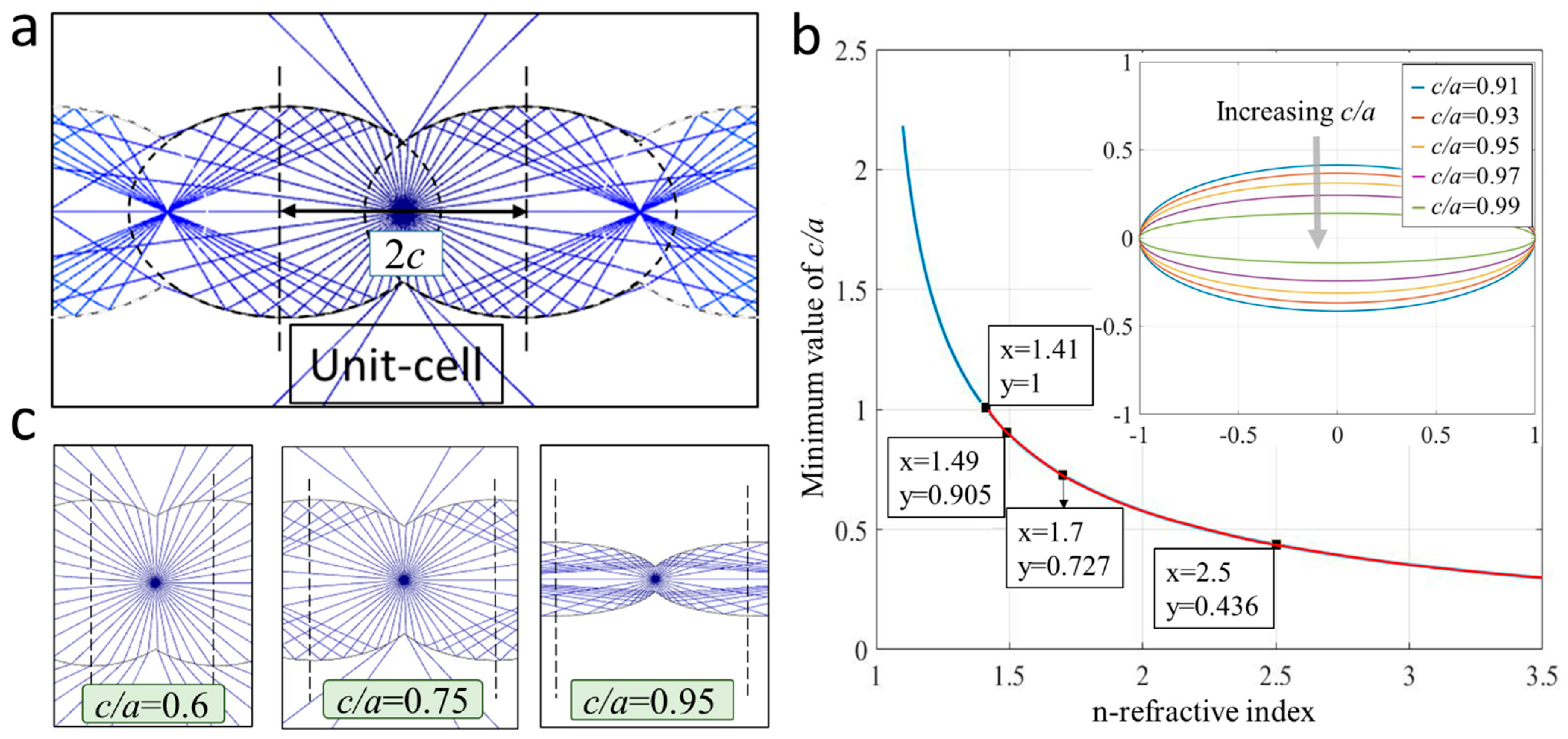
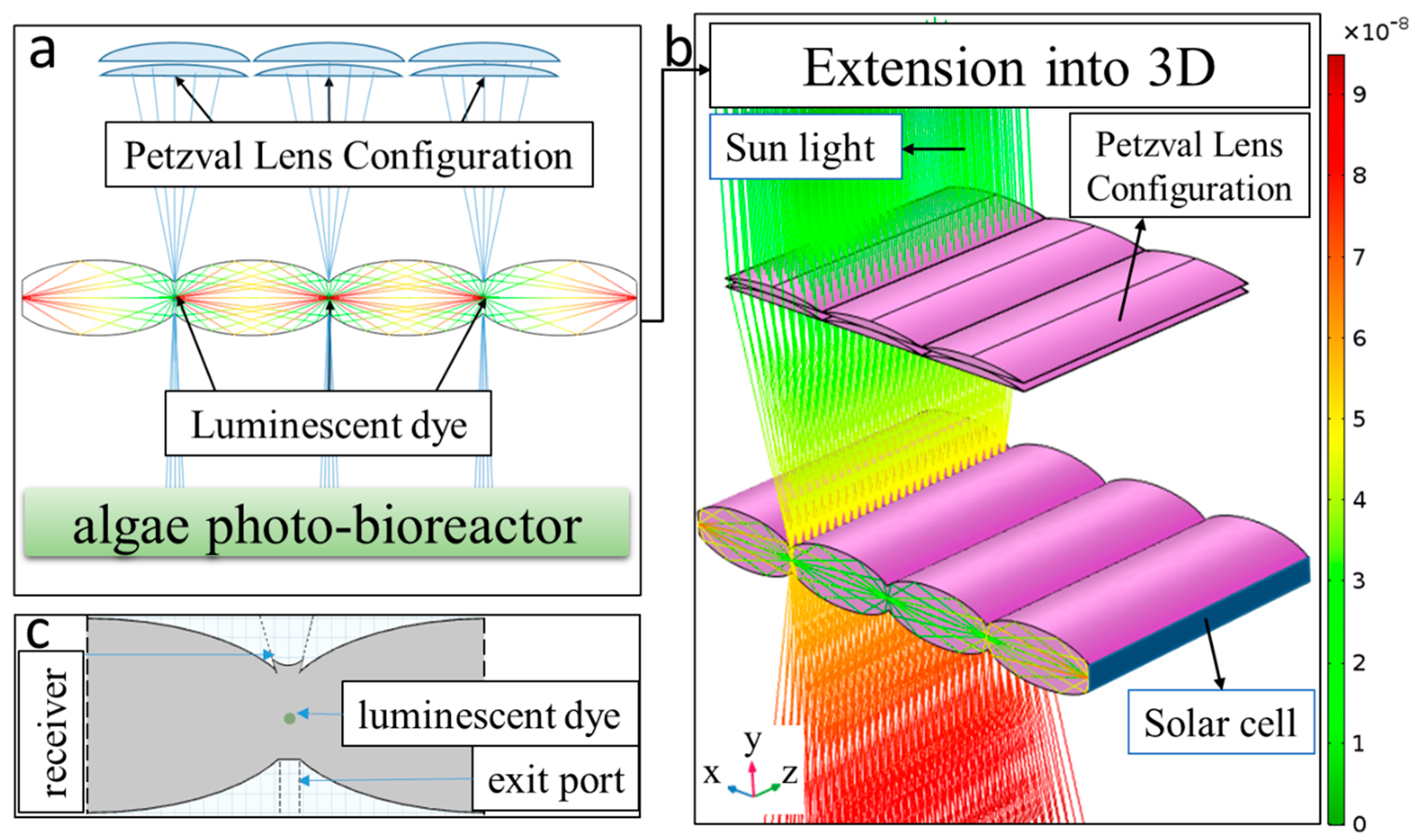

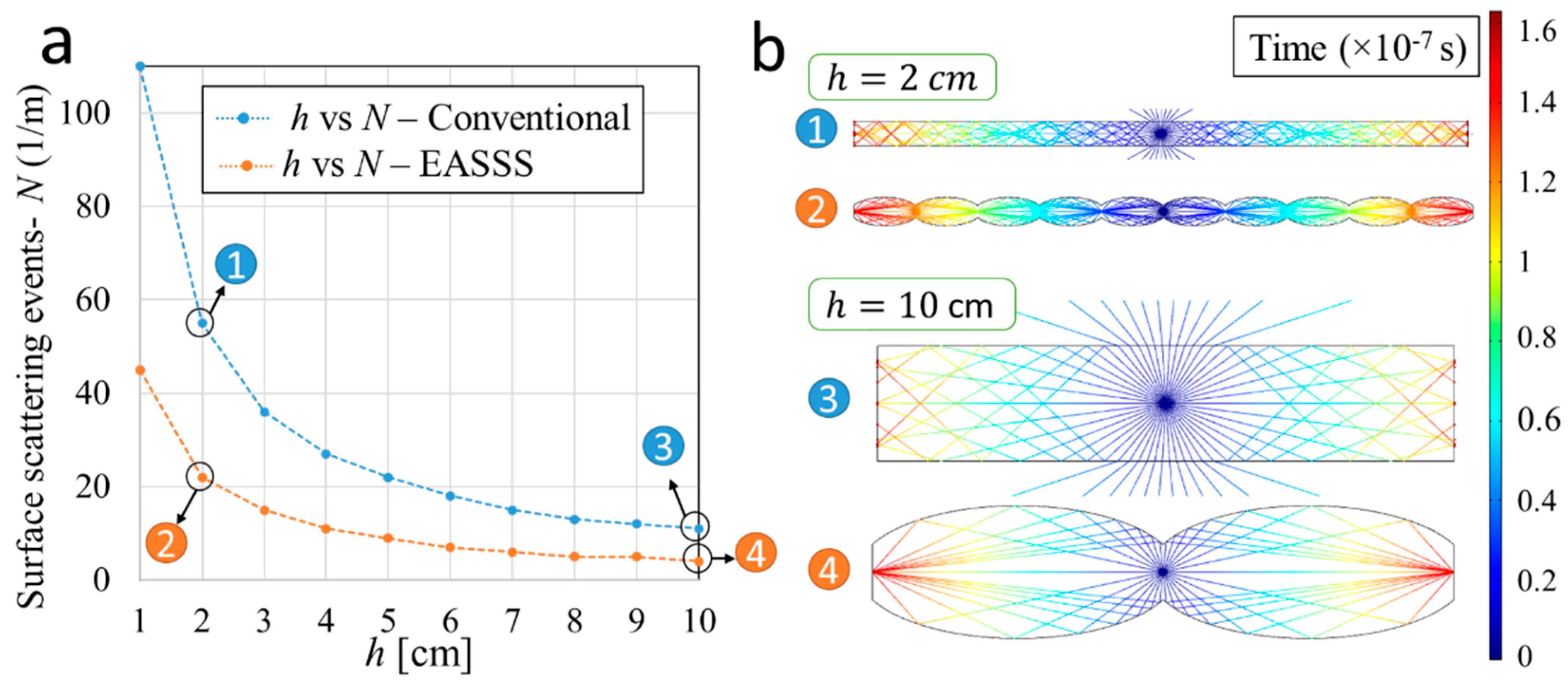
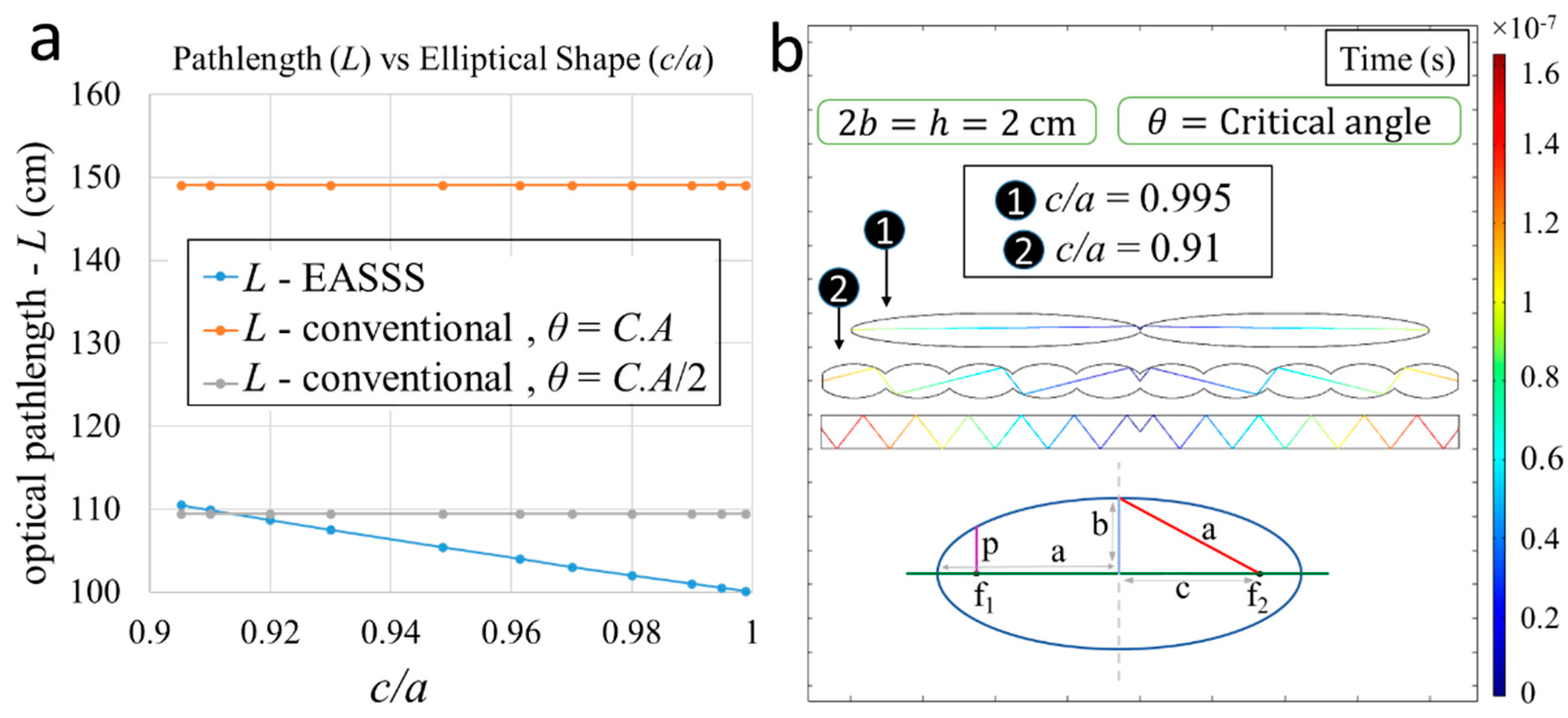
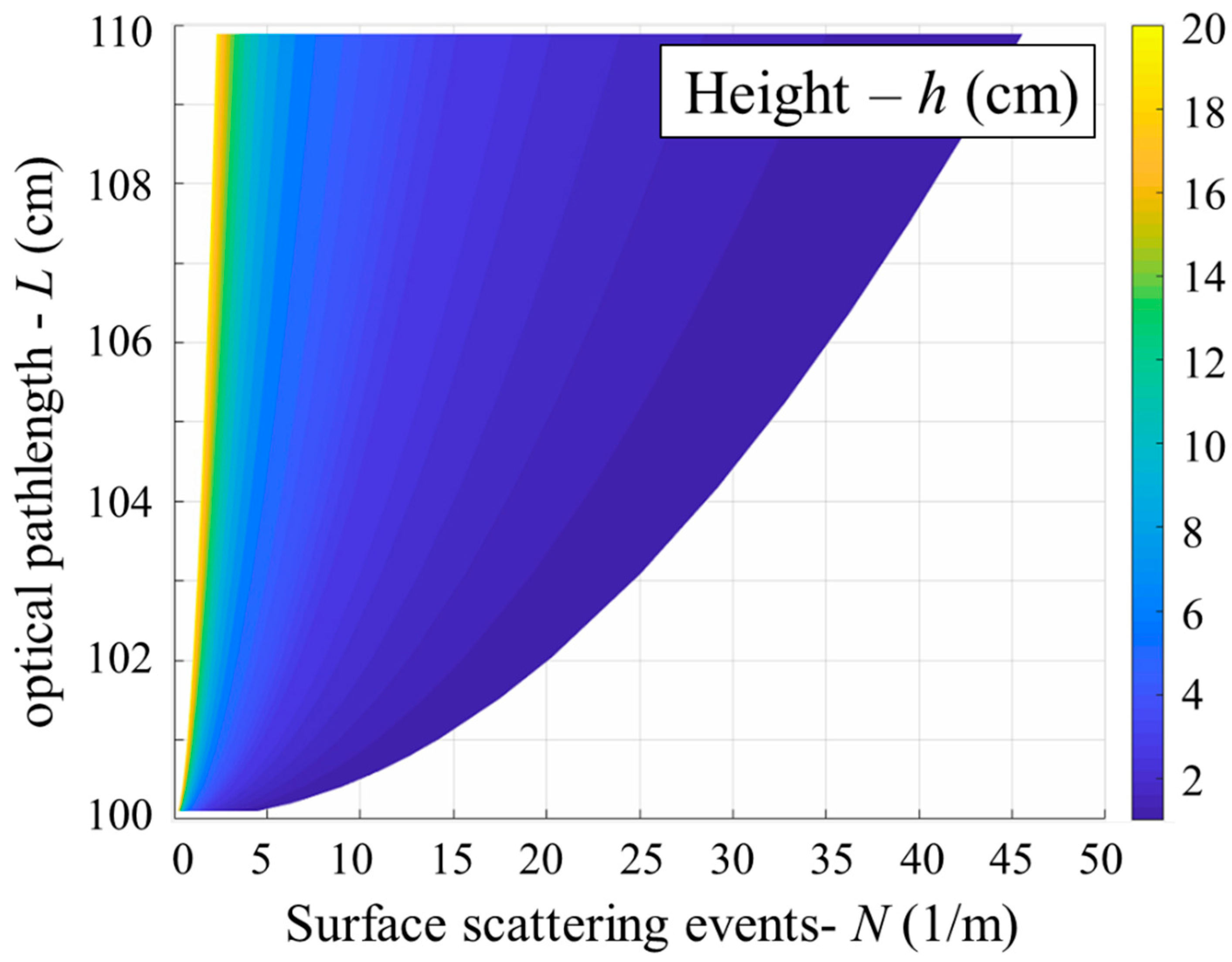
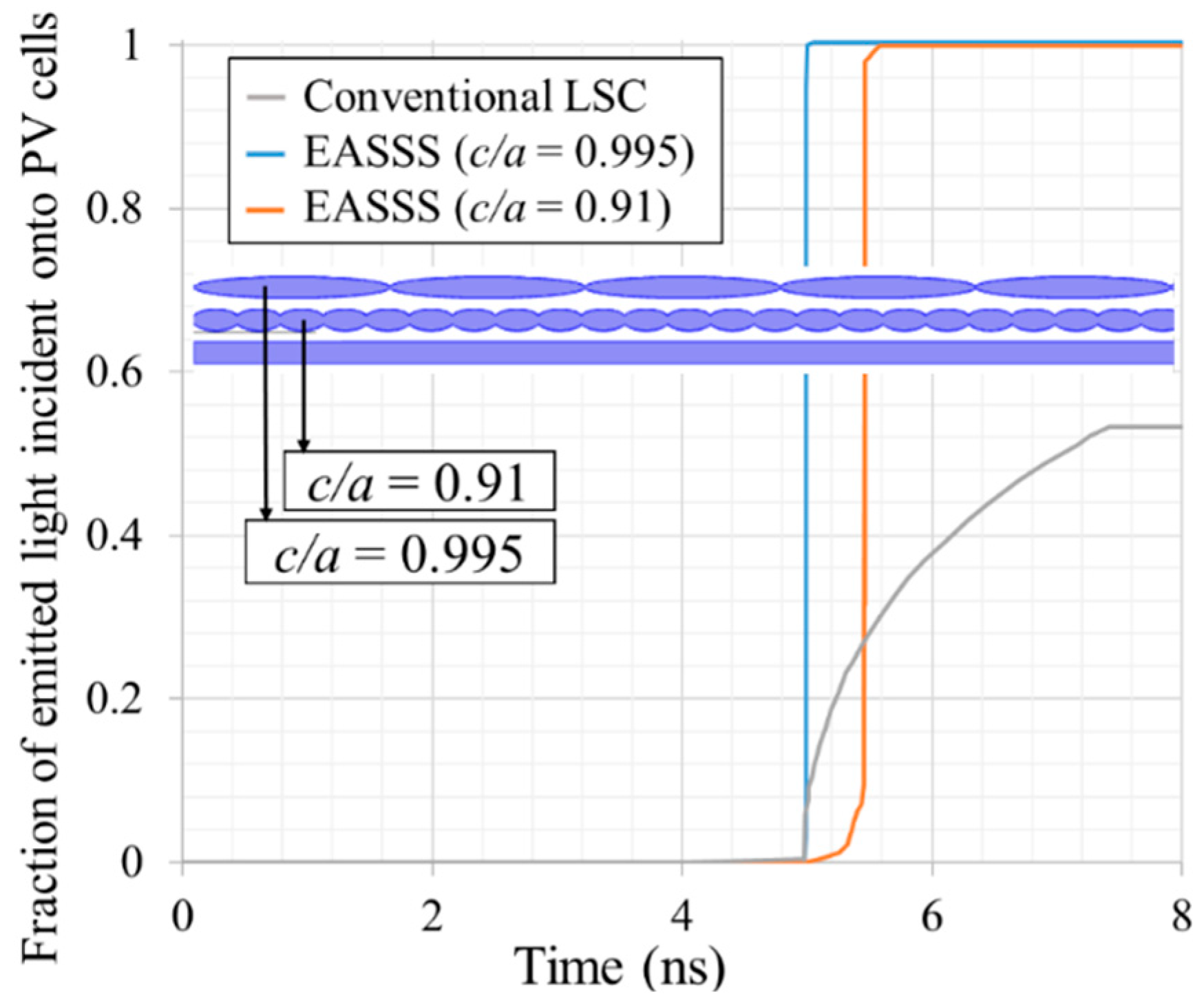

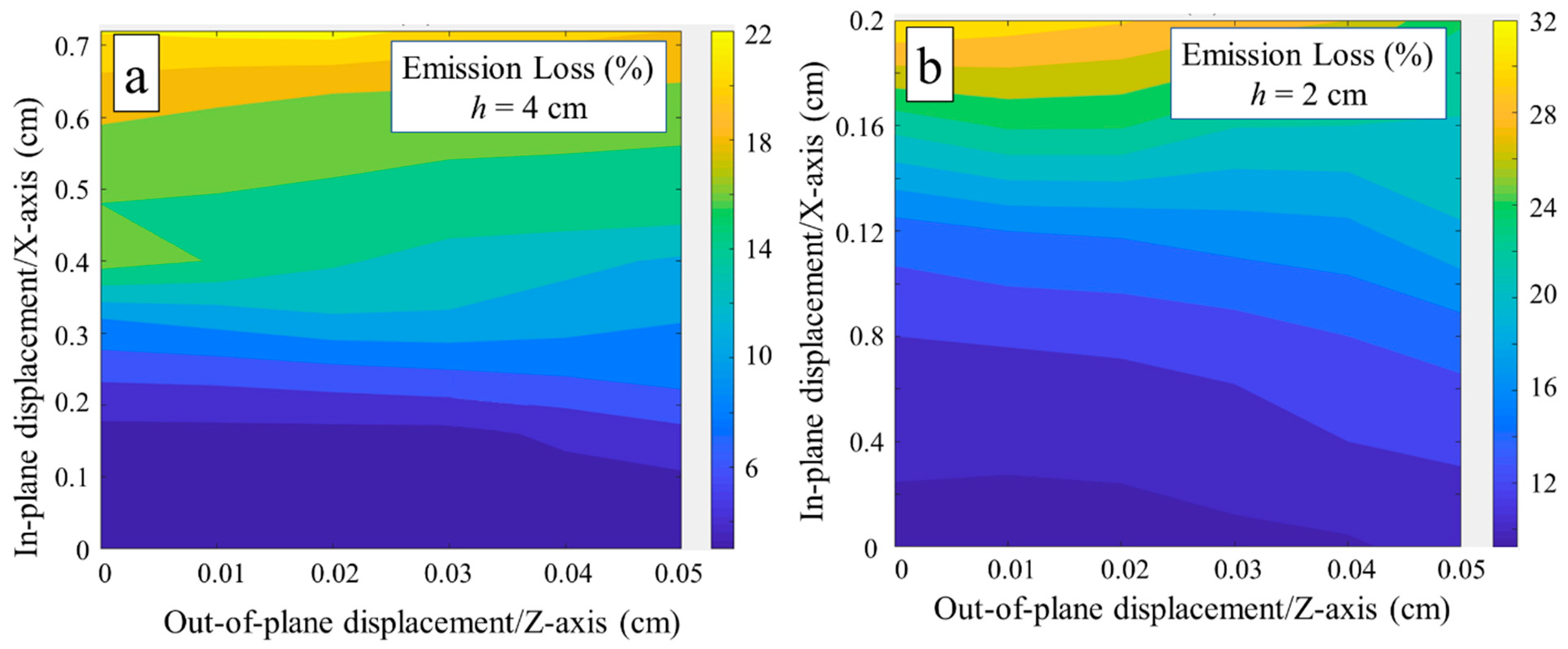
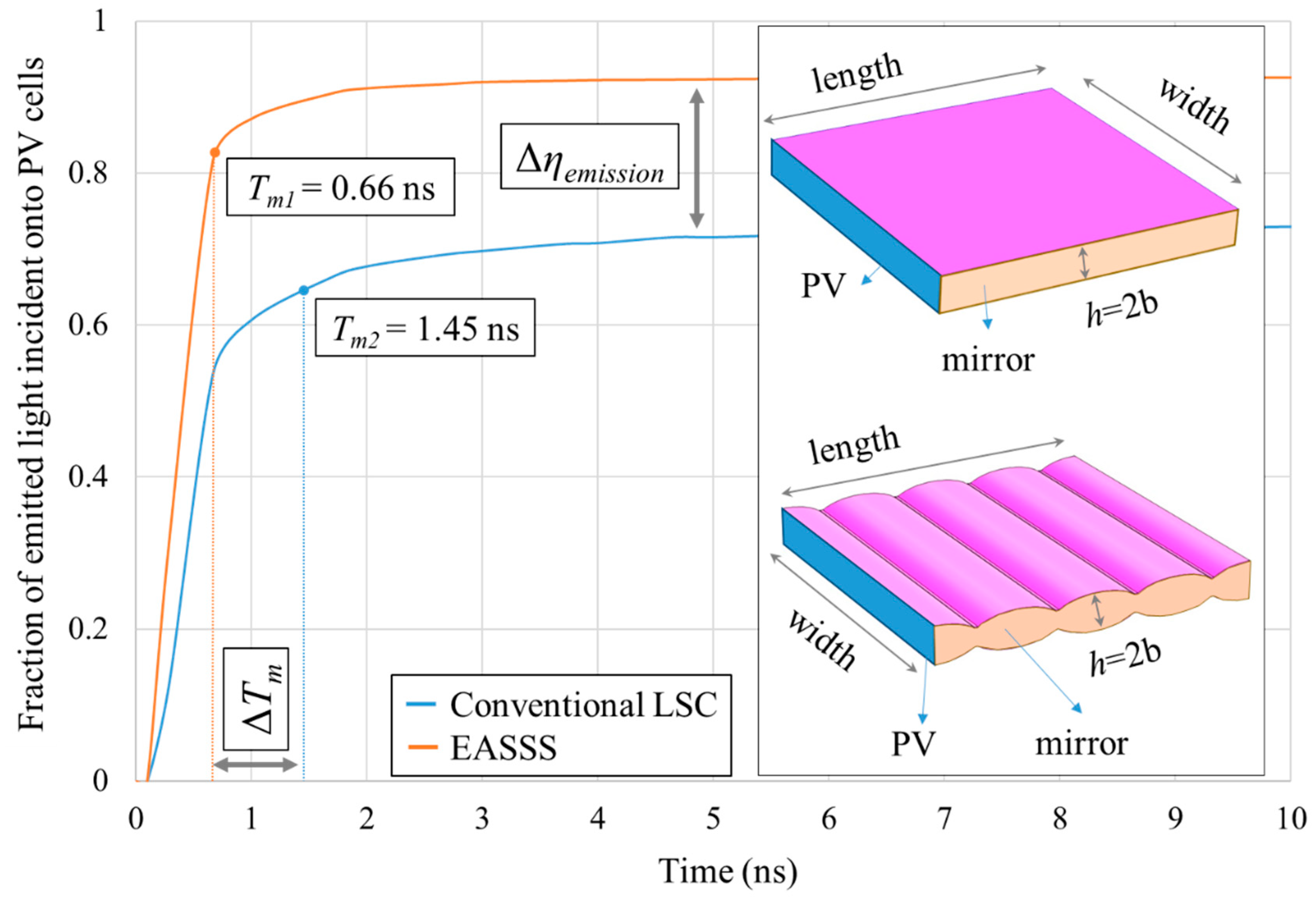
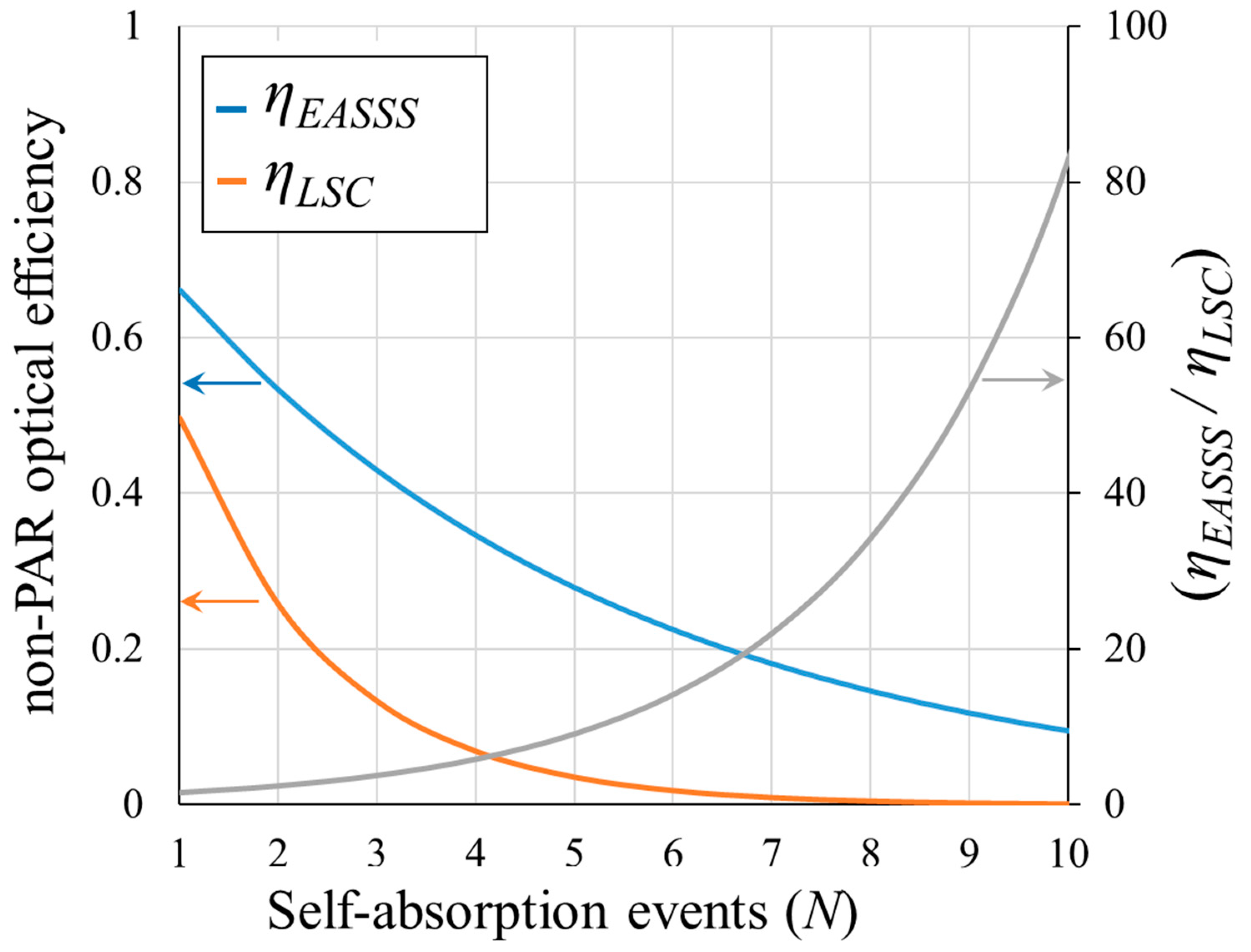
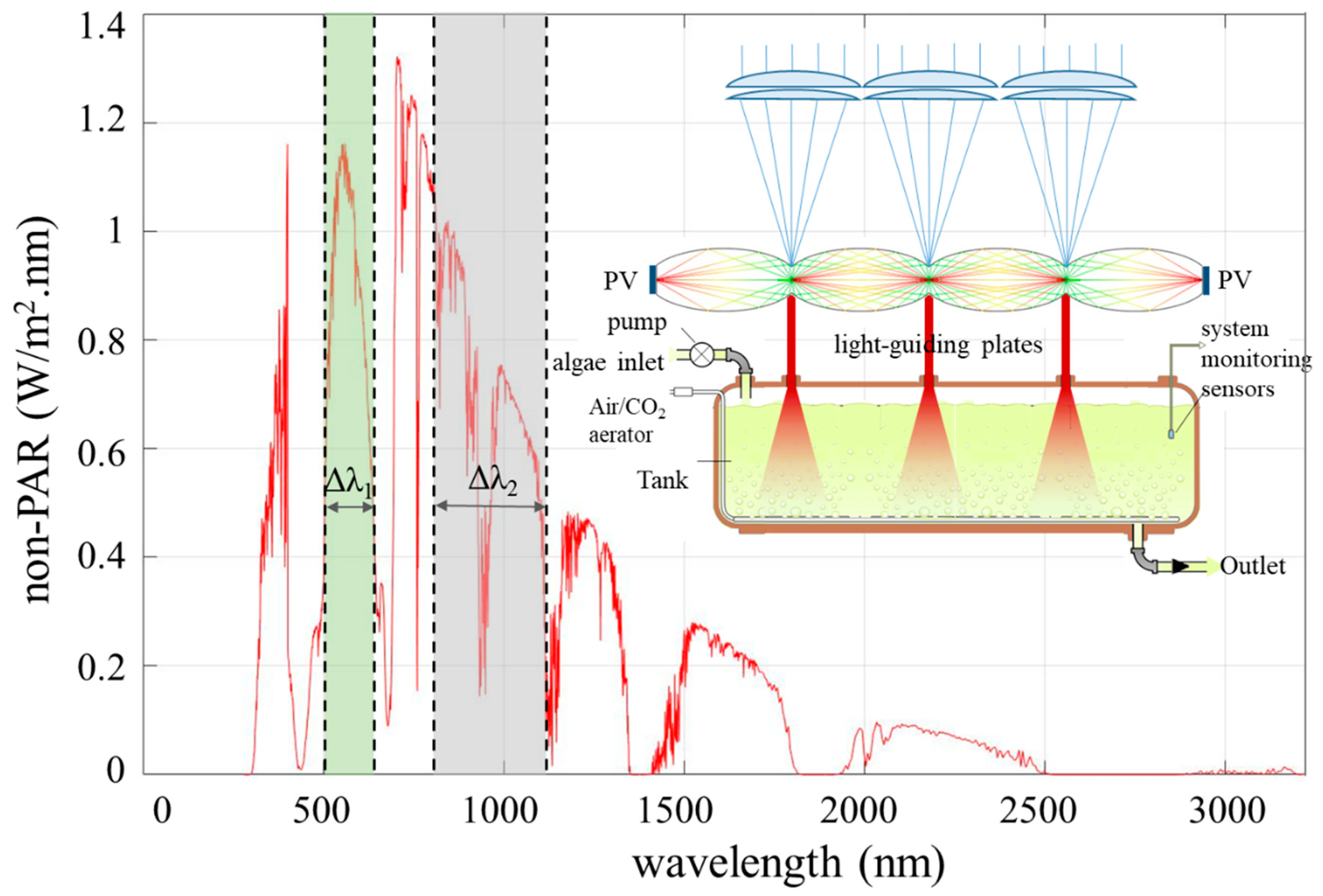
| Solar Concentrator | Mean Photon Traveling Time (ns) | Average Traveling Distance (cm) | Scattering Quantity (Times/Photon) | ηEmission (%) | ηTransmission (%) | ηRoughness (%) | ηgreen/non-PAR-opt (%) | Concentration Factor |
|---|---|---|---|---|---|---|---|---|
| EASSS | 0.66 | 13.29 | 2.38 | 92.6 | 93.6 | 93 | 63 | 2.77 |
| LSC | 1.45 | 29.11 | 6.92 | 74 | 86.45 | 81 | 47.2 | 2.07 |
Publisher’s Note: MDPI stays neutral with regard to jurisdictional claims in published maps and institutional affiliations. |
© 2021 by the authors. Licensee MDPI, Basel, Switzerland. This article is an open access article distributed under the terms and conditions of the Creative Commons Attribution (CC BY) license (https://creativecommons.org/licenses/by/4.0/).
Share and Cite
Talebzadeh, N.; O’Brien, P.G. Elliptic Array Luminescent Solar Concentrators for Combined Power Generation and Microalgae Growth. Energies 2021, 14, 5229. https://doi.org/10.3390/en14175229
Talebzadeh N, O’Brien PG. Elliptic Array Luminescent Solar Concentrators for Combined Power Generation and Microalgae Growth. Energies. 2021; 14(17):5229. https://doi.org/10.3390/en14175229
Chicago/Turabian StyleTalebzadeh, Nima, and Paul G. O’Brien. 2021. "Elliptic Array Luminescent Solar Concentrators for Combined Power Generation and Microalgae Growth" Energies 14, no. 17: 5229. https://doi.org/10.3390/en14175229
APA StyleTalebzadeh, N., & O’Brien, P. G. (2021). Elliptic Array Luminescent Solar Concentrators for Combined Power Generation and Microalgae Growth. Energies, 14(17), 5229. https://doi.org/10.3390/en14175229






